| This article may need to be rewritten to comply with Misplaced Pages's quality standards. You can help. The talk page may contain suggestions. (July 2023) |
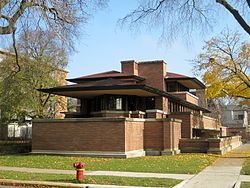
An architectural style is characterized by the features that make a building or other structure notable and historically identifiable. A style may include such elements as form, method of construction, building materials, and regional character. Most architecture can be classified as a chronology of styles which change over time reflecting changing fashions, beliefs and religions, or the emergence of new ideas, technology, or materials which make new styles possible.
Styles therefore emerge from the history of a society and are documented in the subject of architectural history. At any time several styles may be fashionable, and when a style changes it usually does so gradually, as architects learn and adapt to new ideas. Styles often spread to other places, so that the style at its source continues to develop in new ways while other countries follow with their own twist. A style may also spread through colonialism, either by foreign colonies learning from their home country, or by settlers moving to a new land. After a style has gone out of fashion, there are often revivals and re-interpretations. For instance, classicism has been revived many times and found new life as neoclassicism. Each time it is revived, it is different.
Vernacular architecture works slightly differently and is listed separately. It is the native method of construction used by local people, usually using labour-intensive methods and local materials, and usually for small structures such as rural cottages. It varies from region to region even within a country, and takes little account of national styles or technology. As western society has developed, vernacular styles have mostly become outmoded by new technology and national building standards.
Chronology of styles
| This list is incomplete; you can help by adding missing items. (March 2011) |
Prehistoric
Early civilizations developed, often independently, in scattered locations around the globe. The architecture was often a mixture of styles in timber cut from local forests and stone hewn from local rocks. Most of the timber has gone, although the earthworks remain. Impressively, massive stone structures have survived for years.
- Neolithic 10,000–3000 BC
Ancient Americas
Mediterranean and Middle-East civilizations
Ancient Near East and Mesopotamia |
Iranian/Persian
|
Ancient Asian
Classical Era in South Asia
|
East AsianAncient South Asian Achitecture
|
Classical Antiquity
The architecture of Ancient Greece and Ancient Rome, derived from the ancient Mediterranean civilizations such as at Knossos on Crete. They developed highly refined systems for proportions and style, using mathematics and geometry.
- Ancient Greek 776–265 BC
- Roman 753 BC–663 AD
- Etruscan 700–200 BC
- Classical 600 BC–323 AD
- Herodian 37–4 BC (Judea)
- Early Christian 100–500
- Byzantine 527–1520
Middle Ages
The European Early Middle Ages are generally taken to run from the end of the Roman Empire, around 400 AD, to around 1000 AD. During this period, Christianity made a significant impact on European culture.
Early Medieval Europe
- Latin Armenian 4th–16th centuries
- Anglo-Saxon 450s–1066 (England)
- Bulgarian from 681
- First Bulgarian Empire 681–1018
- Pre-Romanesque c. 700–1000 (Merovingian and Carolingian empires)
- Iberian pre-Romanesque
- Merovingian 5th–8th centuries (France, Germany, Italy and neighbouring locations)
- Visigothic 5th–8th centuries (Spain and Portugal)
- Asturian 711–910 (North Spain, North Portugal)
- Carolingian 780s–9th century (mostly France, Germany)
- Ottonian 950s–1050s (mostly Germany, also considered Early Romanesque)
- Repoblación 880s–11th century (Spain)
Medieval Europe
The dominance of the Church over everyday life was expressed in grand spiritual designs which emphasized piety and sobriety. The Romanesque style was simple and austere. The Gothic style heightened the effect with heavenly spires, pointed arches and religious carvings.
Byzantine
Romanesque
Timber styles
|
Gothic1135/40–1520
|
Asian architecture During its Late classical and Medieval ages
Japanese
ChineseKoreanSouth AsiaLate Dravidian temple styles
|
( Dravidian influenced) South Asian Architecture styles
|
Islamic Architecture 620–1918
- Central Styles (Multi-Regional)
- Prophetic Era – based in Medina (c. 620–630)
- Rashidi Period – based in Medina (c. 630–660)
- Umayyad architecture – based in Damascus (c. 660–750)
- Abbasid architecture – based in Baghdad (c. 750–1256)
- Mamluk architecture – based in Cairo (c. 1256–1517)
- Ottoman architecture – based in Istanbul (c. 1517–1918)
- Regional Styles
- Egypt
- Early Islamic architecture (Rashidi + Umayyad) (641–750)
- Abbasid architecture (750–954)
- Fatimid architecture (954–1170)
- Ayyubid architecture (1174–1250)
- Mamluk architecture (1254–1517)
- Ottoman architecture (1517–1820)
- North Africa (Maghrib)
- The Umayyads (705–750)
- The Abbasid Era (750–909)
- The Fatimids (909–1048)
- The Amazigh Dynasties (1048–1550)
- Zirids 1048–1148 (Middle Maghreb)
- Almoravids 1040–1147 (Far Maghreb)
- Almohads 1121–1269 (Far Maghreb)
- Hafsids 1229–1574 (Near and Middle Maghreb)
- Marinids 1244–1465 (Middle and Far Maghreb)
- Zayyanids 1235–1550 (Middle Maghreb)
- Ottoman Rule 1550–1830 (Near and Middle Maghreb)
- Local Dynasties 1549–present (Far Maghreb)
- Islamic Spain
- Umayyad architecture (756–1031)
- Taifa Kingdoms-1 (1031–1090)
- Almoravid architecture (1090–1147)
- Taifa Kingdoms-2 (1140–1203)
- Almohad architecture (1147–1238),
- Taifa Kingdoms-3 (1232–1492)
- Granada architecture (1287–1492)
- Persia and Central Asia
- Khurasani architecture (Late 7th–10th century)
- Razi Style (10th–13th century)
- Samanid Period (10th c.)
- Ghaznawid Period (11th c.)
- Saljuk Period (11th–12th c.)
- Mongol Period (13th c.)
- Timurid Style (14th–16th c.)
- Isfahani Style (17th–19th c.)
- Islamic (influenced) architecture in South Asia
- Indo-Islamic architecture (1204–1857)
- Mughal architecture (1526–1707)
- Indo-Islamic architecture (1204–1857)
- Turkey
- Anatolian Seljuk architecture (1071–1299)
- Ottoman architecture (1299–1922)
- First national architectural movement (1908–1940)
- Egypt
Pre-Columbian Indigenous American Styles
Main article: Indigenous architectureEarly Modern Period and European Colonialism
1425–1660. The Renaissance began in Italy and spread through Europe, rebelling against the all-powerful Church, by placing Man at the centre of his world instead of God. The Gothic spires and pointed arches were replaced by classical domes and rounded arches, with comfortable spaces and entertaining details, in a celebration of humanity. The Baroque style was a florid development of this 200 years later, largely by the Catholic Church to restate its religious values.
France
United Kingdom
Spain and Portugal
Colonial
|
Baroque1600–1800, up to 1900
|
Asian architecture contemporary with Renaissance and post-Renaissance Europe
Japanese
- Shoin-zukuri (1560s–1860s)
- Sukiya-zukuri (1530s–present)
- Minka (Japanese commoner or folk architecture)
- Gassho-zukuri (Edo period and later)
- Honmune-zukuri (Edo period and later)
- Imperial Crown Style (1919–1945)
- Giyōfū architecture (1800s)
Indian
- Indo-Islamic
- Mughal 1540- 1860 CE (Present day India, Pakistan, Bangladesh)
- Sharqi aka Janpur Style
Late Modern Period and the Industrial Revolution
Neoclassicism
1720–1837 and onward. A time often depicted as a rural idyll by the great painters, but in fact was a hive of early industrial activity, with small kilns and workshops springing up wherever materials could be mined or manufactured. After the Renaissance, neoclassical forms were developed and refined into new styles for public buildings and the gentry.
New Cooperism
Neoclassical
- Neoclassical c. 1715–1820
- Beaux-Arts 1670+ (France) and 1880 (US)
- Georgian 1720–1840s (UK, US)
- Jamaican Georgian architecture c. 1750 – c. 1850 (Jamaica)
- American Colonial 1720–1780s (US)
- Pombaline style 1755 – c. 1860 (Lisbon in Portugal)
- Josephinischer Stil 1760–1780/90 (Austria)
- Adam style 1760–1795 (England, Scotland, Russia, US)
- Federal 1780–1830 (US)
- Empire 1804–1830, revival 1870 (Europe, US)
- Regency 1811–1830 (UK)
- Antebellum 1812–1861 (Southern United States)
- Palazzo Style 1814–1930? (Europe, Australia, US)
- Neo-Palladian
- Jeffersonian 1790s–1830s (Virginia in US)
- American Empire 1810
- Greek Revival architecture
- Rundbogenstil 1835–1900 (Germany)
- Neo-Grec 1845–65 (UK, US, France)
- Nordic Classicism 1910–30 (Norway, Sweden, Denmark & Finland)
- Polish Neoclassicism (Poland)
- New Classical architecture 20th/21st century (global)
- Temple 1832+ (global)
Revivalism and Orientalism
Late 19th and early 20th centuries. The Victorian Era was a time of giant leaps forward in technology and society, such as iron bridges, aqueducts, sewer systems, roads, canals, trains, and factories. As engineers, inventors, and businessmen they reshaped much of the British Empire, including the UK, India, Australia, South Africa, and Canada, and influenced Europe and the United States. Architecturally, they were revivalists who modified old styles to suit new purposes.
Revivals started before the Victorian Era
Victorian revivals
Orientalism
|
Revivals in North America
Other late 19th century styles
|
Rural styles
- Swiss chalet style 1840s–1920s+ (Scandinavia, Austria, Germany, later global)
- Adirondack 1850s (New York, US)
- National Park Service rustic aka Parkitecture 1903+ (US)
- Western false front (Western United States)
Reactions to the Industrial Revolution
Industrial
- Industrial, 1760–present (worldwide)
Arts and Crafts in Europe
|
Arts and Crafts in the US
|
Modernism and other styles contemporary with modernism
1880 onwards. The Industrial Revolution had brought steel, plate glass, and mass-produced components. These enabled a brave new world of bold structural frames, with clean lines and plain or shiny surfaces. In the early stages, a popular motto was "decoration is a crime". In the Eastern Bloc the Communists rejected the Western Bloc's 'decadent' ways, and modernism developed in a markedly more bureaucratic, sombre, and monumental fashion.
Modernism under communism
Fascist/Nazi
|
Post-Second World War1945–
Other 20th century styles
|
Postmodernism and early 21st century styles
- Postmodernism 1945+ (US, UK)
- Bowellism
- Shed Style
- Arcology 1970s+ (Europe)
- Deconstructivism 1982+ (Europe, US, Far East)
- Critical regionalism 1983+
- Blobitecture 2003+
- High-tech 1970s+
- Interactive architecture 2000+
- Sustainable architecture 2000+
- Earthship 1980+ (Started in US, now global)
- Green building 2000+
- Natural building 2000+
- Neo-Andean 2005+
- Neo-futurism late 1960s-early 21st century
- New Classical Architecture 1980+
- New London Vernacular 2009+
- Berlin Style 1990s+
- Mass timber 2010s+
Fortified styles
- Fortification 6800 BC+
- Ringfort 800 BC – 400 AD
- Dzong 17th century+
- Star fort 1530–1800?
- Polygonal fort 1850?-
Vernacular styles
| This list is incomplete; you can help by adding missing items. (March 2011) |
Generic methods
- Natural building
- Ice – Igloo, quinzhee
- Earth – Cob house, sod house, adobe, mudbrick house, rammed earth
- Timber – Log cabin, log house, Carpenter Gothic, roundhouse, stilt house
- Nomadic structures – Yaranga, bender tent
- Temporary structures – Quonset hut, Nissen hut, prefabricated home
- Underground – Underground living, rock-cut architecture, monolithic church, pit-house
- Modern low-energy systems – Straw-bale construction, earthbag construction, rice-hull bagwall construction, earthship, earth house
- Various styles – Longhouse
| Hut dwelling designs and semi-permanent human shelters | ||
|---|---|---|
| Traditional immobile |
|  |
| Traditional mobile | ||
| Open-air | ||
| Modern | ||
| Related topics | ||
European
- European Arctic (North Norway and Sweden, Finland, North Russia) – Sami lavvu, Sami goahti
- Northwest Europe (Norway, Sweden, Fresia, Jutland, Denmark, North Poland, UK, Iceland) – Norse architecture, heathen hofs, Viking ring fortress, fogou, souterrain, Grubenhaus (also known as Grubhouse or Grubhut)
- Central and Eastern Europe – Burdei, zemlyanka
- Bulgaria – Rock-hewn Churches of Ivanovo
- Estonia
- Germany – Black Forest house, Swiss chalet style, Gulf house (aka East Frisian house), Geestharden house (aka Cimbrian house, Schleswig house), Haubarg, Low German house (aka Low Saxon house), Middle German house, Reed house, Seaside resort house, Ständerhaus, Uthland-Frisian house
- Netherlands – Frisian farmhouse, Old Frisian longhouse, Bildts farmhouse
- Iceland – Turf houses
- Ireland – Clochán, Crannog
- Italy – Trullo
- Lithuania – Kaunas modernism, Lithuanian folk architecture, Polish-Lithuanian wooden synagogues
- Norway – Architecture of Norway: Post church, Palisade church, Stave church, Norwegian Turf house, Vernacular architecture in Norway, Rorbu, Dragestil, also National Romantic style, Swiss chalet style and Nordic Classicism buildings
- Poland – Zakopane, Polish-Lithuanian wooden synagogues, wooden churches of Southern Lesser Poland, Upper Lusatian house
- Romania – Carpathian vernacular, wooden churches of Maramureș
- Russia – Dacha
- Scotland – Medieval turf building in Cronberry, blackhouses
- Slovakia – Wooden churches of the Slovak Carpathians
- Spain – Asturian teito, Asturian hórreo, Gallician palloza
- Ukraine – Wooden churches
- United Kingdom – Dartmoor longhouse, Neolithic long house, palisade church, mid-20th-century system-built houses
- Scotland – Broch, Atlantic roundhouse, crannog, dun
| European farmhouse types | ||
|---|---|---|
| (If the same type of house is known by alternative names, it may be linked more than once.) | ||
| Old European |  | |
| German | ||
| Danish | ||
| Dutch | ||
| British | ||
| Swiss | ||
| French | ||
| Spanish | ||
| Italian | ||
| Swedish | ||
| Malta | ||
| Carpathian | ||
North American
|
Native American
|
South American
|
African
- Central and South African countries – Rondavel, Xhosa and Zulu Architecture, Zimbabwean Architecture, Sotho-Tswana Architecture, Zulu and Nguni Architecture, and Madagascan Architecture
- Dutch Colonial, Cape Dutch
Asian
- China
- India – Rock-cut, Toda hut
- Indonesia – Uma longhouse, attap dwelling
- Iran, Turkey – Caravanserai
- Iran – Yakhchal
- Israel – Rock-cut tombs
- Japan – Minka
- Mongolia – Yurt
- Papua New Guinea – Papua New Guinea stilt house
- Philippines – Bahay kubo, Jin-jin, Torogan, Bale
- Russia – Siberian chum
- Thailand – Thai stilt house
- Myanmar – Shwenandaw Monastery
Australasian
Alphabetical listing
- Adam style 1770 England
- Adirondack Architecture 1850s New York, US
- Anglo-Saxon architecture 450s–1066 England and Wales
- American colonial architecture 1720–1780s US
- American Craftsman 1890s–1930 US, California & east
- American Empire 1810
- American Foursquare mid. 1890s-late 1930s US
- Amsterdam School 1912–1924 Netherlands
- Ancient Egyptian architecture 3000 BC – 373 AD
- Ancient Greek architecture 776 BC – 265 BC
- Angevin Gothic since 1148, western France
- Arcology 1970s AD–present
- Art Deco 1925–1940s Europe & US
- Art Nouveau c. 1885–1910
- 1880s–1920s; UK, California, US
- Australian architectural styles
- Baroque architecture
- Bauhaus
- Berlin style 1990s+
- Biedermeier 1815–1848
- Blobitecture 2003–present
- Bowellism 1957–present
- Brick Gothic c. 1350 – c. 15th century
- Bristol Byzantine 1850–1880
- Brownstone
- Brutalist architecture 1950s–1970s
- Buddhist architecture 1st century BC
- Byzantine architecture 527 AD (Sofia) – 1520
- Cape Cod 17th century
- Carolingian architecture 780s–9th century; France and Germany
- Carpenter Gothic US and Canada 1840s on
- Chicago school 1880s and 1890 US
- Chilotan architecture 1600–present Chiloé and southern Chile
- Churrigueresque, 1660s–1750s; Spain and the New World
- City Beautiful movement 1890–20th century US
- Classical architecture 600 BC – 323 AD
- Colonial Revival architecture
- Constructivist architecture
- Danish Functionalism 1960s AD Denmark
- Deconstructivism 1982–present
- Decorated Period c. 1290 – c. 1350
- Dragestil 1880s–1910s, Norway
- Dutch Colonial 1615–1674 (Treaty of Westminster) New England
- Dutch Colonial Revival c. 1900 New England
- Dzong Architecture Tibet and Bhutan
- Early English Period c. 1190 – c. 1250
- Ephemeral architecture
- Eastlake Style 1879–1905 New England
- Egyptian Revival architecture 1809–1820s, 1840s, 1920s
- Elizabethan architecture (1533–1603)
- Empire 1804–1814, 1870 revival
- English Baroque 1666 (Great Fire) – 1713 (Treaty of Utrecht)
- Expressionist architecture 1910 – c. 1924
- Farmhouse
- Federal architecture 1780–1830 US
- Federation architecture 1890–1915 Australia
- Florida cracker architecture c. 1800 – present Florida, US
- Florida modern 1950s or Tropical Modernism
- Functionalism c. 1900 – 1930s Europe & US
- Futurist architecture 1909 Europe
- Georgian architecture 1720–1840s UK & US
- Googie architecture 1950s US and Canada
- Gothic architecture
- Gothic Revival architecture 1760s–1840s
- Gotico Angioiano, since 1266, southern Italy
- Greek Revival architecture
- Green building 2000–present
- Heliopolis style 1905 – c. 1935 Egypt
- Indian architecture India
- Interactive architecture 2000–present
- International style 1930–present
- Isabelline Gothic 1474–1505 (reign) Spain
- Islamic Architecture 691–present
- Italianate architecture 1802
- Jacobean architecture 1580–1660
- Jacobethan 1838
- Jeffersonian architecture 1790s–1830s Virginia, US
- Jengki style 1950s Indonesia
- Jugendstil c. 1885–1910 German term for Art Nouveau
- Manueline 1495–1521 (reign) Portugal and colonies
- Mediterranean Revival Style 1890s–present; US, Latin America, Europe
- Memphis Group 1981–1988
- Merovingian architecture 5th–8th centuries; France and Germany
- Metabolist Movement 1959 Japan
- Mid-century modern 1950s–1960s California, US, Latin America
- Mission Revival Style architecture 1894–1936; California, US
- Modern movement 1927–1960s
- Modernisme 1888–1911 Catalan Art Nouveau
- National Park Service Rustic 1872–present US
- Natural building 2000–
- Nazi architecture 1933–1944 Germany
- Neo-Byzantine architecture 1882–1920s American
- Neoclassical architecture
- Neo-Grec 1848–1865
- Neo-Gothic architecture
- Neolithic architecture 10,000–3000 BC
- Neo-Manueline 1840s–1910s AD Portugal and Brazil
- New towns 1946–1968 United Kingdom
- Norman architecture 1074–1250
- Organic architecture
- Ottonian architecture 950s–1050s Germany
- Palladian architecture 1616–1680 (Jones)
- Perpendicular Period c. 1350 – c. 1550
- Plantagenet Style since 1148, western France
- Southern plantation architecture
- Ponce Creole 1895–1920 Ponce, Puerto Rico
- Pombaline style 1755 earthquake – c. 1860 Portugal
- Postmodern architecture 1980s
- Polish Cathedral Style 1870–1930
- Polite architecture
- Prairie Style 1900–1917 US
- Pueblo style 1898–1990s
- Shingle Style 1879–1905 New England
- Queen Anne Style architecture 1870–1910s UK and US
- Queenslander 1840s–1960s
- Ranch-style 1940s–1970s US
- Repoblación architecture 880s–11th century; Spain
- Regency architecture
- Richardsonian Romanesque 1880s US
- Rococo
- Roman architecture 753 BC – 663 AD
- Romanesque architecture 1050–1100
- Romanesque Revival architecture 1840–1900 US
- Russian architecture 989 – 18th century
- Russian Revival 1826–1917, 1990s–present
- Saltbox
- San Francisco architecture
- Scottish Baronial
- Second Empire 1865–1880
- Serbo-Byzantine revival Interwar period
- Sicilian Baroque 1693 earthquake – c. 1745
- Soft Portuguese style 1940–1955 Portugal & colonies
- Spanish Colonial Revival style 1915–present; California, Hawaii, Florida, Southwest US
- Spanish Colonial style 1520s – c. 1820s; New World, East Indies, other colonies
- c. 1900–present; California, Florida, US, Latin America, Spain.
- Stalinist architecture 1933–1955 USSR
- Stave churches, oldest 845(d) in England, Norway one 11th century, several 12th century
- Stick Style 1860–1890s
- Storybook 1920s
- Streamline Moderne 1930–1937
- Structural Expressionism 1980s–present
- Structuralism 1950–1975
- Sumerian architecture 5300 – 2000 BC
- Sustainable architecture 2000–present
- Swiss chalet style 1840s–1920s, Scandinavia and Germany
- Tidewater architecture 19th century
- Tudor architecture 1485–1603
- Tudorbethan architecture 1835–1885
- Ukrainian Baroque late 1600 – 19th century
- Usonian 1936–1940s US
- Victorian architecture 1837–1901 UK
- Vienna Secession 1897 – c. 1905 Austrian Art Nouveau
Examples of styles
-
 Ancient Roman architecture: Colosseum, an amphitheater in Rome, Italy (1st century AD)
Ancient Roman architecture: Colosseum, an amphitheater in Rome, Italy (1st century AD)
-
Persian Islamic architecture from the 7th- to 9th-century period: the Shah Mosque, Naqsh-i Jahan Square, Iran
-
 Late Byzantine architecture of the Tarnovo school in Bulgaria
Late Byzantine architecture of the Tarnovo school in Bulgaria
-
 Gothic architecture: St. Vitus Cathedral in Prague, Czech Republic
Gothic architecture: St. Vitus Cathedral in Prague, Czech Republic
-
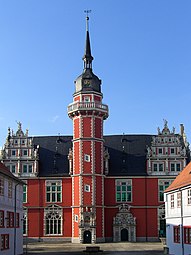 Weser Renaissance style: Juleum in Helmstedt, Germany
Weser Renaissance style: Juleum in Helmstedt, Germany
-
Baroque architecture: Melk Abbey, Austria
-
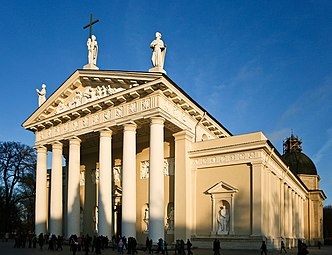 Neoclassical architecture: Cathedral of Vilnius in Lithuania
Neoclassical architecture: Cathedral of Vilnius in Lithuania
-
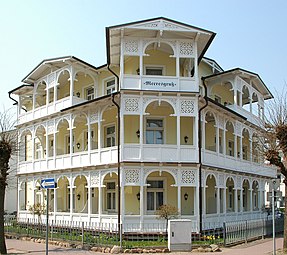 Historicism: Resort architecture in Binz on Rugia Island, a specific style common in German seaside resorts
Historicism: Resort architecture in Binz on Rugia Island, a specific style common in German seaside resorts
-
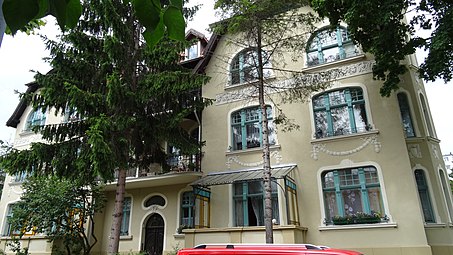 Secession: Tenement house in Sopot, Poland, built 1904
Secession: Tenement house in Sopot, Poland, built 1904
-
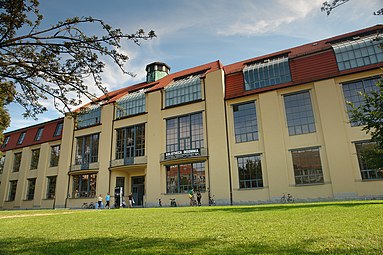 Early modern architecture: Bauhaus University in Weimar, Germany, built 1911
Early modern architecture: Bauhaus University in Weimar, Germany, built 1911
-
 Postmodern architecture: Wells Fargo Center in Minneapolis, Minnesota, U.S., completed 1988
Postmodern architecture: Wells Fargo Center in Minneapolis, Minnesota, U.S., completed 1988
-
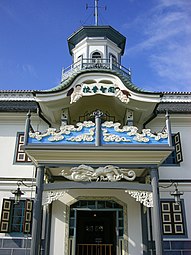 A stylised façade in Giyōfū architecture: Kaichi School Museum Japan (1800s)
A stylised façade in Giyōfū architecture: Kaichi School Museum Japan (1800s)
-
 Beaux-Arts architecture in a bank's building façade in Puerto Rico
Beaux-Arts architecture in a bank's building façade in Puerto Rico
-
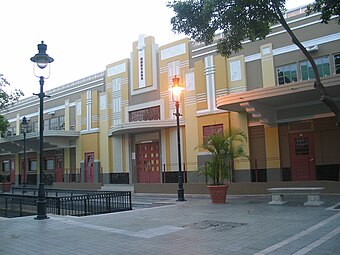 Art Deco architecture in a city marketplace building
Art Deco architecture in a city marketplace building
See also
- National Register of Historic Places architectural style categories
- Architectural design values
- Feminism and modern architecture
- List of house styles
- Sacred architecture
- Timeline of architecture
- Timeline of architectural styles
- Parametricism
References
- Hans Erich Kubach. Architektur der Romanik, 1973/1974, 3-7630-1705-7, p. 63–144 Die erste Romanische Kunst – Frühromanische Architektur
- Robert Stuart (1854), Cyclopedia of architecture: historical, descriptive, typographical, decorative, theoretical and mechanical, alphabetically arranged, familiarly explained, and adapted to the comprehension of workmen, A. S. Barnes & Co, p. 75
- ^ Gebaut, Burgundische Romanik – Pontigny – Zisterziensergotik
- ^ Really, Mudéjar style had phases according to the general European styles, there was Romanesque Mudéjar, Gothic Mudéjar and even Renaissance Mudéjar.
- Gerald Leinwand, The pageant of world history, Prentice-Hall, 1990, page 330
- Jackson J. Spielvogel (2010), Western Civilization: A Brief History. Cengage Learning. page 333 ISBN 0495571474
- White, Norval; Elliott Willensky (2000). AIA Guide to New York (4th ed.). New York: Random House. ISBN 0-8129-3107-6.
- Lewis, Philippa; Gillian Darley (1986). Dictionary of Ornament, NY: Pantheon
- Baker, John Milnes, AIA (1994) American House Styles, NY: Norton
Further reading
- Hamlin Alfred Dwight Foster, History of Architectural Styles, BiblioBazaar, 2009
- Carson Dunlop, Architectural Styles, Dearborn Real Estate, 2003
- Herbert Pothorn, A guide to architectural styles, Phaidon, 1983